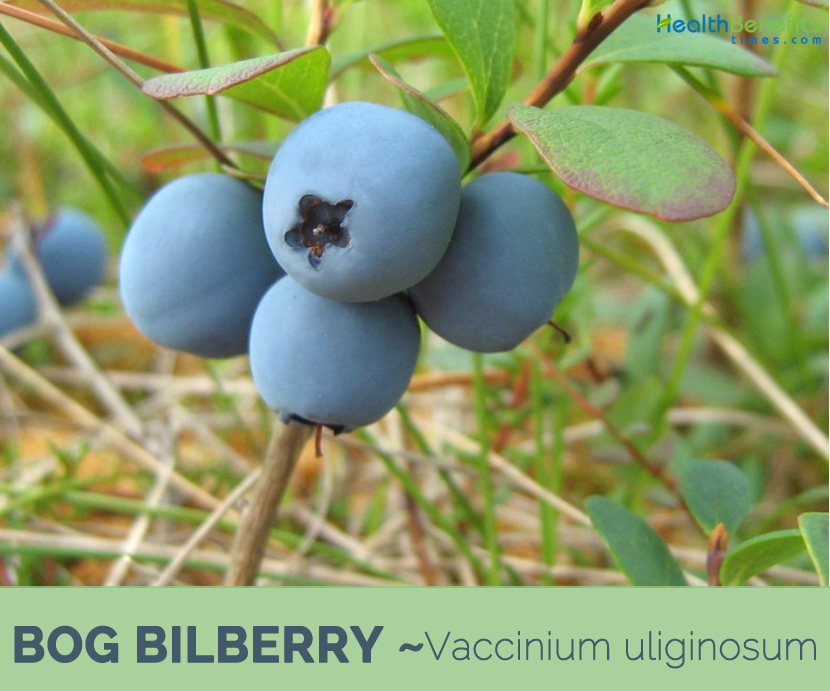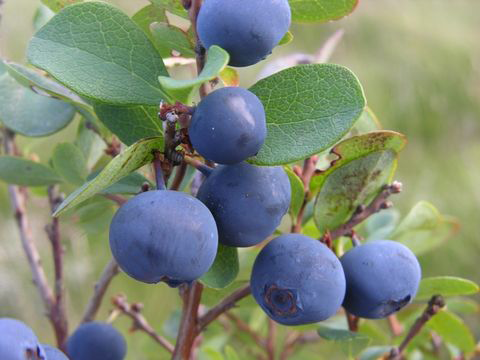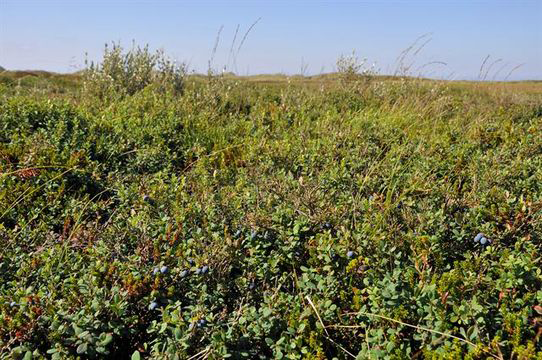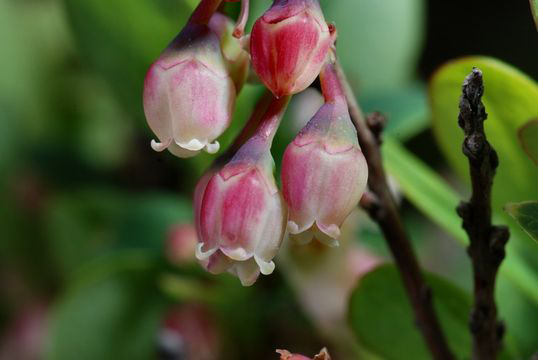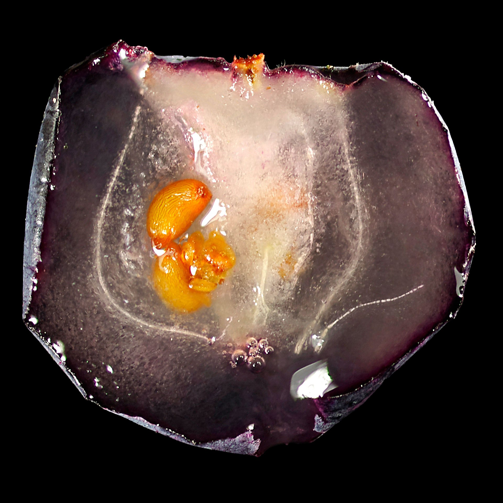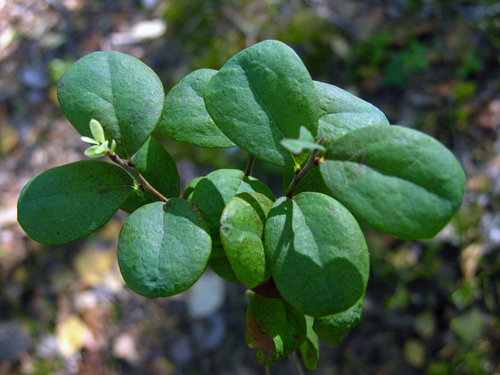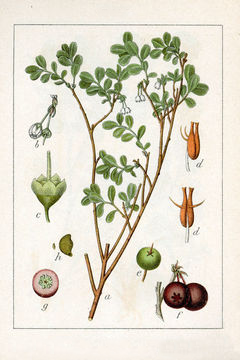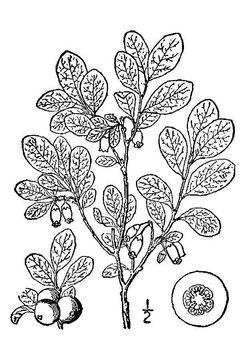| Bog Bilberry Quick Facts |
| Name: |
Bog Bilberry |
| Scientific Name: |
Vaccinium uliginosum |
| Origin |
temperate regions of the Northern HemisphereT |
| Colors |
Green when young turning to dark blue-black as they mature |
| Shapes |
Berry 5–8 millimeters (0.20–0.31 in) diameter |
| Flesh colors |
White |
| Taste |
Sweet |
Vaccinium uliginosum with many common names including Bog bilberry, Bog blueberry, Moorberry, Western-huckleberry, Alpine Blueberry, Northern Bilberry, Bog whortleberry and Ground Hurts is a low, highly branched, deciduous shrub of the heather family (Ericaceae) and Vaccinium genus. The plant is closely related to the blueberry, cranberry, and huckleberry. The plant is native to cool temperate regions of the Northern Hemisphere, at low altitudes in the Arctic, and at high altitudes south to the Pyrenees, the Alps, and the Caucasus in Europe, the mountains of Mongolia, northern China, the Korean Peninsula and central Japan in Asia, and the Sierra Nevada in California and the Rocky Mountains in Utah in North America. Vaccinium is the Latin word for “blueberry” or “whortleberry” and Uliginosum means “full of moisture” or “marshy.” Anthocyanins are responsible for the color of bog bilberries with over 15 different anthocyanins identified from bog bilberries grown in the west coast of Norway
Plant Description
Bog Bilberry is a low, highly branched, deciduous shrub that grows about 10–75 centimeters (0.33–2.46 ft.) tall, rarely 1 meter (3.3 ft.) tall with round, gray-brown, glabrous branches and a creeping rhizome. The plant is found growing in coastal and interior bogs, cotton grass tussock tundra, low shrub tundra, sedge meadows, black or white spruce woodlands, forested areas, rocky or sandy shores of lakes and streams, rock outcrops and barrens. The plant prefers organic or inorganic soils that are generally acidic and is found growing abundantly on well-drained to poorly drained sites. The plant has many green, triangular, erect stems and twigs are slender. Older twigs have gray, shreddy bark.
Leaves
Leaves are alternate, deciduous, from broadly egg-shaped to oval or elliptic, 0.4-3 cm long, 0.2-1.5 cm wide, rounded at tips, tapered at base, glabrous or minutely hairy, with slight bloom, strongly net-veined, margins entire, rolled under somewhat. The undersurface has a protruding, reticulate vein system and is blue-green. The upper surface of the leaves is light matte-green to almost white.
Flower & Fruit
The flowers are arranged in axils of small leaves at the end of short lateral branches. They are hanging and white or reddish in color. The pedicle is encircled at the base with a light brown bud husk. The calyx is fused with the ovary. The fruit is a round or pear-shaped, blue-frosted multi-seeded dark blue-black berry 5–8 millimeters (0.20–0.31 in) diameter, with a white flesh, edible and sweet when ripe in late summer. The light brown seeds are sickle-shaped with sharp ends, and have a punctate-reticulate skin.
Few Traditional uses and benefits of Bog Bilberry
- An infusion of the leaves and sugar has been given to a mother a few days after childbirth in order to help her regain her strength.
- Bog Bilberry is used for gastric and intestinal catarrh, diarrhea and bladder complaints.
Culinary Uses
- Bog blueberries are edible and have good flavor.
- Berries are often picked in large quantities and used in jams, jellies, and pies.
- Fresh or dried leaves can be used for tea.
- The fruit can also be dried and used like raisins.
- A tea is made from the leaves and dried fruits.
- In Korea, bog bilberry is used in infused liquor.
Precautions
- The fruit can cause headaches if they are eaten in large quantities.
- Consumption of large quantities of the fruits may results in queasiness, vomiting, states of intoxication, feelings of weakness and visual disorders.
References:
https://www.itis.gov/servlet/SingleRpt/SingleRpt?search_topic=TSN&search_value=23574#null
https://davesgarden.com/guides/pf/go/95606/
https://npgsweb.ars-grin.gov/gringlobal/taxonomydetail.aspx?id=41063
https://www.pfaf.org/user/Plant.aspx?LatinName=Vaccinium+uliginosum
http://www.floracatalana.net/vaccinium-uliginosum-l
http://www.theplantlist.org/tpl/record/tro-12300065
https://plants.usda.gov/core/profile?symbol=vaul
https://en.wikipedia.org/wiki/Vaccinium_uliginosum
Comments
comments


